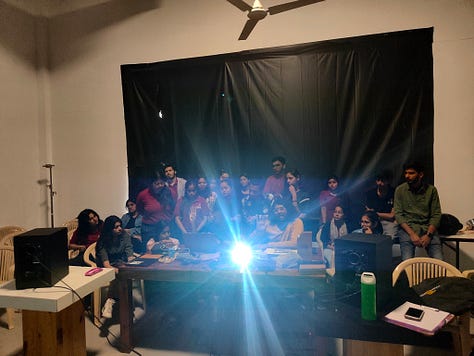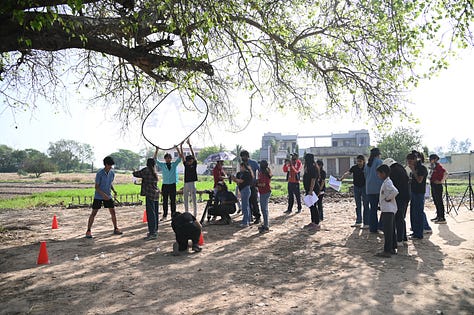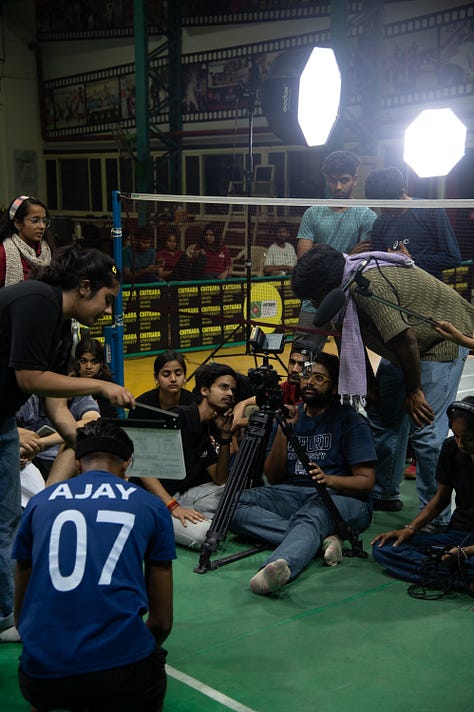Teaching Film in the Age of Design
Part One - Designing a course, and why!
If you didn’t know, there is a boom in Design Education. Anyone and everyone who has been associated with Design in India is aware of this. Private colleges are popping up everywhere, supported by design practitioners from the pioneering design colleges in India. But there is another explosion happening underneath - there is a rising number of film and video courses being offered under the gamut of design education. You must have seen the widely circulated clip of Anurag Kashyap suggesting new filmmakers to head to design schools instead of film schools. Somehow I have found myself in the middle of this phenomenon since the last nine years - three as a student of Film and Video Communication at the National Institute of Design, Ahmedabad, and six as a Visiting Faculty at my alma mater as well as multiple other design colleges in the country, apart from being an independent film practitioner.
I feel there is definitely some truth in what Anurag is saying. Looking at the general trend of films in major film festivals in the past decade - at least since I have been part of the circuit - one sees an increasing number of films in film festivals from students or alumni of Design Colleges. One big reason is definitely the sheer number of films that a design college produces - which I’ll come to later. The second might be faster turn-around times for films in Design colleges because of strict deadlines and semester systems. The third is a democratisation of film equipment - which is cheaper, easily available and higher quality than ever before.
However, I want to write about exactly how do we address this shift in film education - and how do we DESIGN an approach to film education which is inspired - or at least influenced - by design education. I also want to share my experiences and experiments in designing -and implementing - a small but self-contained film course, specifically designed for teaching film in design schools.

Stumbling onto the scene
To give a brief background, I joined the Film and Video Communication Course (FVC) at NID Ahmedabad in 2014. This was also the infamous year when FTII took a ‘zero-year’ and did not take any new admissions. I was devastated, since FTII was where I thought serious filmmakers were made. But when I joined NID, I realised there were more ways of approaching film-education than how traditional film schools approached it. In my interview, Prof. Arun Gupta - then Head of Department - told me very clearly that this is primarily a Direction course, but one also dabbles with the other aspects of film. After finishing my degree, I almost immediately was assisting Arun and other professors in taking courses, and then later on started teaching independently at NID Ahmedabad. In the last six years I have taken various subjects for both UG and PG students of film at NID Ahmedabad, NID Kurukshetra, NID Vijaywada, SPA Delhi and NIFT Kangra.
Most of these places follow a ‘workshop’ system - you have one/two/three week long workshops on one subject. Although this system is great to deep dive into specific topics, as a visiting faculty I felt that it also meant that after the workshop I had very limited interaction with students. Given the nature of film - being a sum of multiple elements that exist and play continuously all at once - I felt that there was a lot of contextualisation that was required to actually drive things home. Students needed to spend time with an idea, process it, try it out, play with it, and then they might get insights that they would need to then discuss and debate with the faculty. The workshop system did not account for this, since the next workshop was already at the doorstep once the first got over. That meant a change of faculty, style of teaching, philosophy, approach etc. I feel the role of in-house faculties became crucial in providing that continuity and contextualisation, but it is a very difficult task to juggle all the admin work, classes and extra-curricular activities and still keep energy reserves for those discussions. Needless to say, I felt that I needed more interactiveness - and maybe a different approach - to film education.
An opportunity presents itself
In 2020, in the midst of the raging pandemic, Prof Manpal Setia - erstwhile Head of Dept. (Visual Communication) at NID Kurukshetra - started a UG course in Communication Design at Chitkara Design School in Chandigarh. Here at Chitkara he designed the course in a way that he kept the 4th Semester as completely dedicated to Filmmaking. I loved the idea, and when he approached me to oversee the semester, I felt that this was a space where one could try out an alternative design towards film education - one that is based loosely on the syllabus designed at NID Ahmedabad, but where one has the continuous contact that I felt was crucial. Although the first attempt - early 2021 - was thwarted by the Second Wave of the pandemic, we finished two successful courses in 2022/23, which resulted in very interesting outcomes and a total of seven short films, which I felt that needs sharing, especially with the broader film and design community.
The course was to be designed for an undergraduate course, but with a crucial caveat - the students hardly had any exposure to films, or any prior interest in learning how to make them. A clean slate, so to speak. The course structure gave me three months of teaching time. I decided to break the three months into four sections; Pre-production, Production, Post-production and Practice Projects.
Pre-Production (One Month)
I started the Pre-production phase with two weeks of Media Appreciation, a slightly expanded version of Film Appreciation that we learnt at NID. Apart from watching and understanding/critiquing cinema, I also added a mix of musicians and artists - Indian and International, pop to classical and multiple other genres. I felt by exposing the students to so many different forms we were able to have conversations about more abstract concepts like rhythm, flow and pace. It was easier for students to identify these concepts in music and art and then apply the same understanding to cinema.
You can find a detailed course outline here.
The next two weeks were dedicated to Writing for Film. This was also based on the scriptwriting workshop that Arun Gupta took for us at NID, but with more slightly more time spent on theory and structure. The first week was about writing and building characters; observation exercises, character backstories, pivotal moments in their lives, to writing character bios and lookboards. The second week was about storytelling; introduction to the three act structure, understanding and writing beats of a story, building a narrative, and then finally writing a 10-page script.
You can find a detailed course outline with exercises here.


Production (Two Weeks)
These two weeks are fashioned after the Elements of Direction course that I undertook at NID, but with more structure and direction. On the first day I broke down the medium of cinema into its individual elements - Image, Audio and Time. Every day we divided the class into groups of 4 - Director, Cinematographer, Production and Sound Recordist/Editor - and gave them one exercise, which they had to finish by the morning of the next day, when we saw the exercises together. We built up the exercises everyday, starting with simple elements, and adding more and more complexity as the course progressed. Dividing the departments meant each person was responsible for their own department and we gave them feedback for the same, which we used to inculcate a professional attitude within the classroom. This also meant that creative differences had clear resolutions - the final call rested with the person responsible for that department.
This course, I feel, truly uses the Design Process and adapts it to film education - a new exercise everyday is akin to a new brief, the process of doing the exercise follows the problem solving process, and the review the next day helped gain insights into how the final solution can be improved upon. Doing these exercises repeatedly meant that there was a continuous chain of trial and feedback, which led to great results, as I’ll discuss later.



At the end of the course we shared a form where each student can evaluate themselves and every other student on three metrics - creativity, teamwork and reliability. This form was not shared with the students, rather it gave us a good foundation to understand what feedback to give each of them. At the end of the course we did an individual feedback session with each student. Students who were ranked low on creativity by their peers - but who we thought actually had good ideas- we were able to work on their communication so that they were able to share their ideas more with their batch. The vice versa was also true. This helped us give very targeted feedback that really helped the students.
You can find a detailed course outline with exercises here. Leo Paapam, who assisted me in the course and has been my colleague at Buddhijeev since the last two years, designed a Notion Template that we used to track the progress of each student throughout the course, which you can access here.
Post-Production (Two Weeks)
This was primarily an Editing course, but we inculcated basics of Sound Design into the second week. For the first three days we gave the students basic continuity exercises - without sound - to help them understand the basics of editing. Then we gave them demos on how to edit with sound, and then I gave them multiple exercises from older short films and footages, and we discussed how to arrange them to tell a story. Conversations about rhythm, flow and pace were an integral part of this course, and since the students were already aware and had somewhat understood these abstract concepts, they were able to participate and grasp these ideas better.
Practice Projects
The last month I divided the class into teams of 10 students each, and depending on the first two months I divided them into Direction, Camera, Writing, Sound, Production and Logistics. The first week and a half all the teams worked together on a short film. I wrote and directed, and Leo, who has been assisting me with the course, shot the film, and A Bhaskar Rao did Sound Recording. The students assisted the departments that they had been assigned in their groups. We followed most of the steps a typical film production would follow, including casting with auditions, script breakdown and storyboarding, location scouting, logistics etc. I wrote the script keeping in mind that there should be a day scene, a night scene, an indoor scene and an outdoor scene. This gave the students the widest range of situations to understand production, lighting and logistics.



The last three weeks (approx) the students worked on one film per group, where they went through everything that we had been through throughout the course and made a short film (under 15 mins) on their own, with us as mentors.
More to come!
In this piece I wanted to primarily deal with the course design part of the experience. However, there have been a lot of learnings from my end beyond just the academic potential of film education. I feel there is a lot to be said about film education as a team-building initiative, especially at the undergraduate level. Another dimension that I had not foreseen, but came to the fore in my experience of this course, were the almost therapeutic effects of filmmaking, especially for a generation right out of Covid induced captivity. I will delve more on these topics, with examples from my classes, in the next blog. Please do follow us or subscribe to be updated when it comes out!
I would request that if you use my course outlines or exercises, or Leo’s excellent Notion Template, please credit us wherever possible, and please do write to us about your experiences and experiments with them at buddhijeev42@gmail.com. We would love to hear about them, and hopefully put them up at our blog.
As always, thank you for reading!
If you like this blog, you can follow more content here - videos on YouTube, posts and stories on Instagram, and articles on this blog. If you think our ideas are interesting and would like to know more about the walk, please try and subscribe. We promise we won't spam!
The writer Shridhar Sudhir is an independent filmmaker, academic, artist, and founder of Buddhijeev Studios. You can check out his website here.





What is the cost of the post- production course? And when will it happen? Also is design school a good platform for film/ video editors too? Thank you.